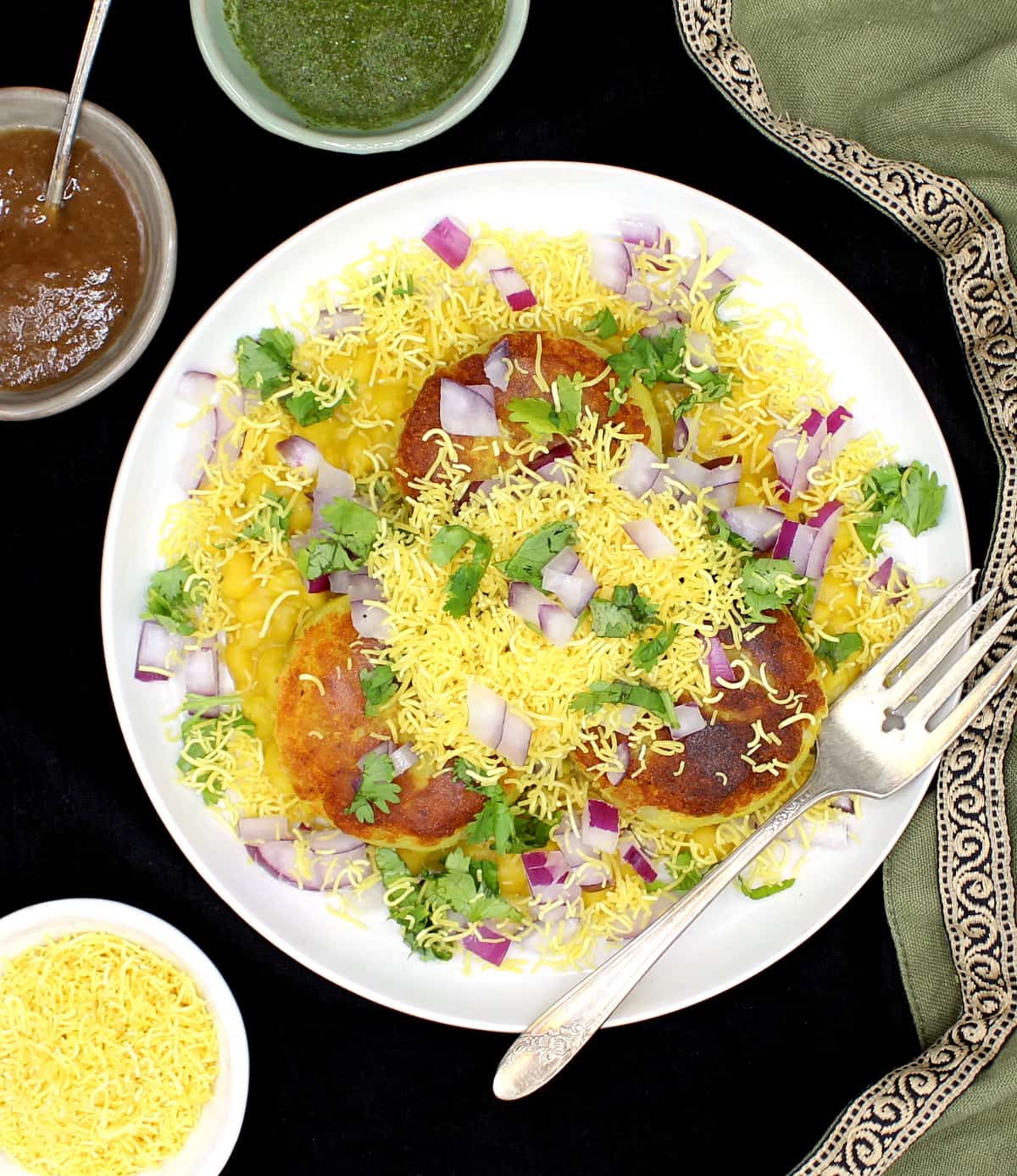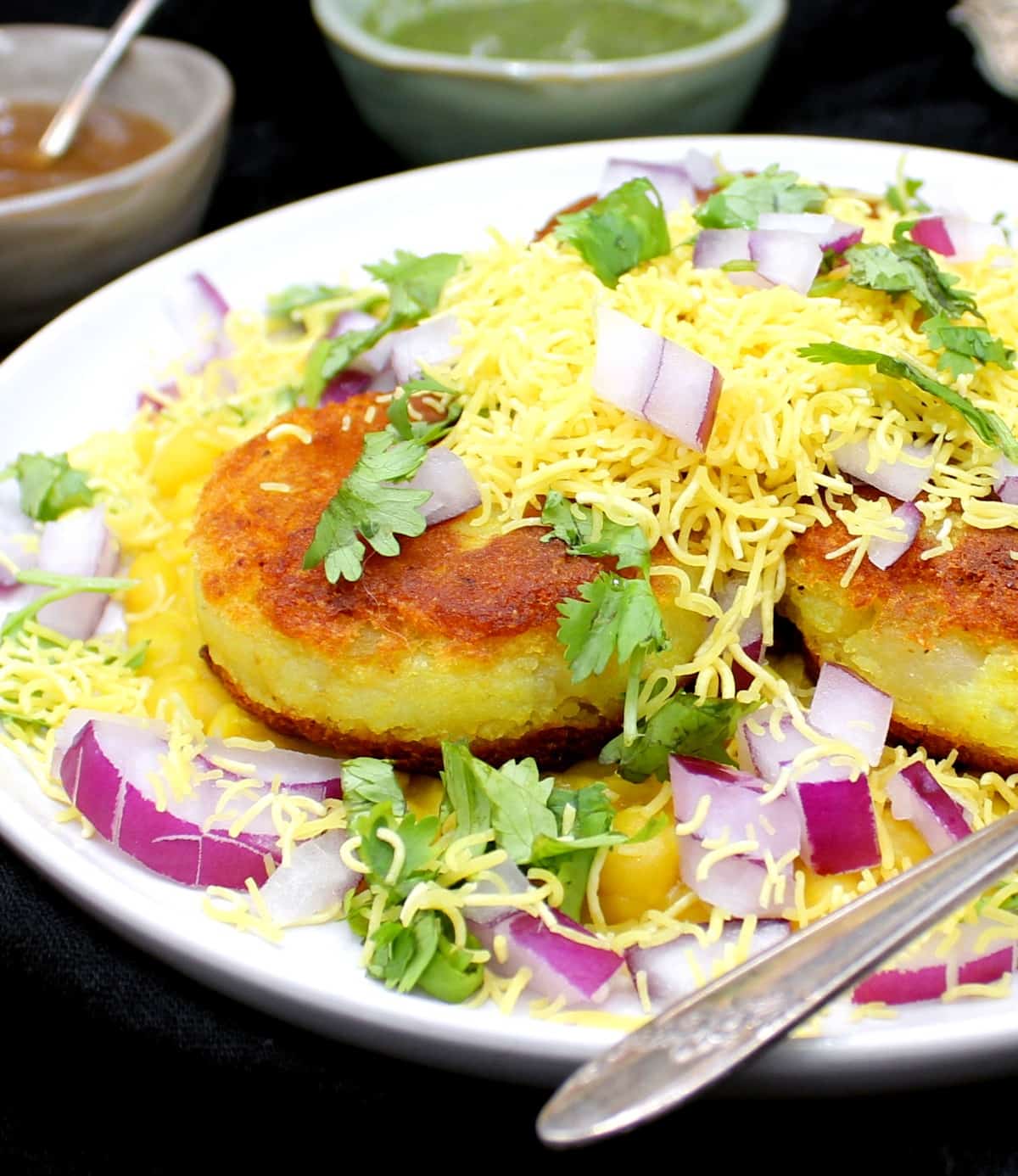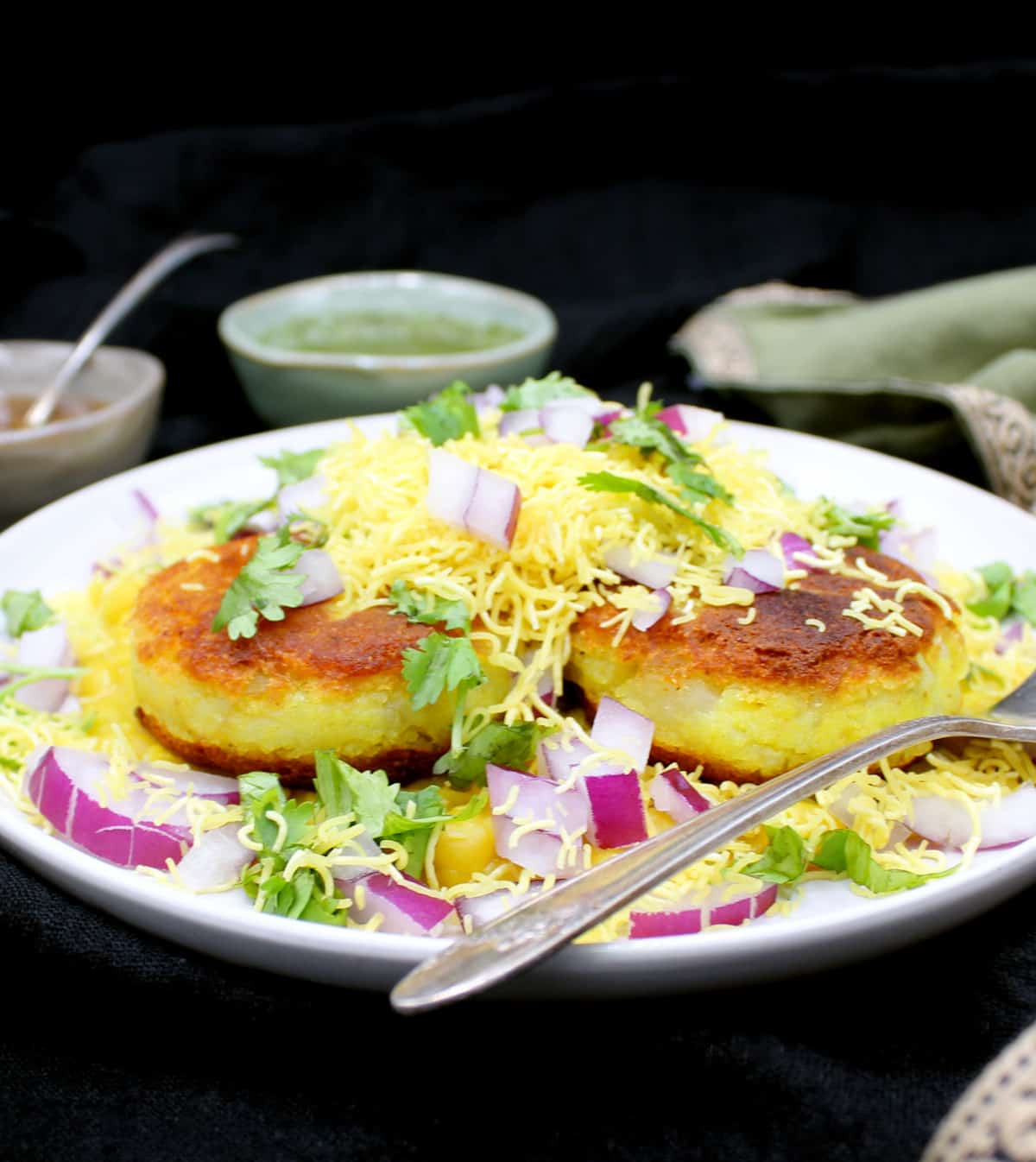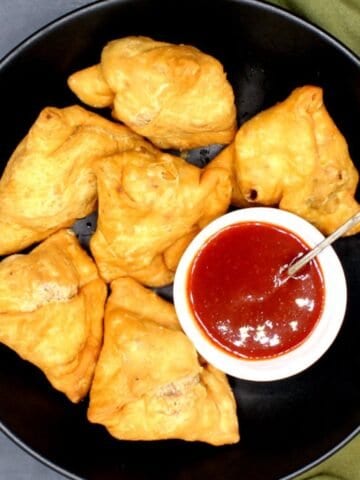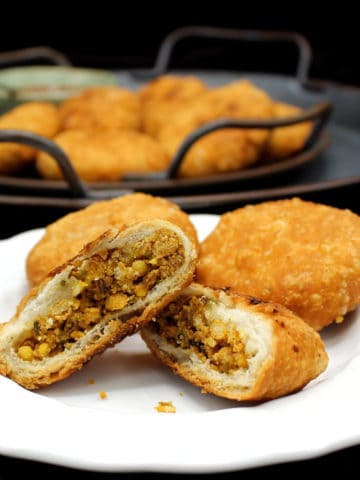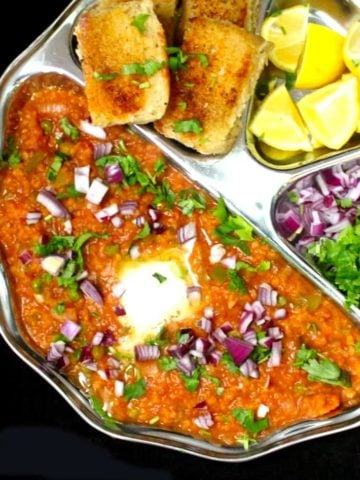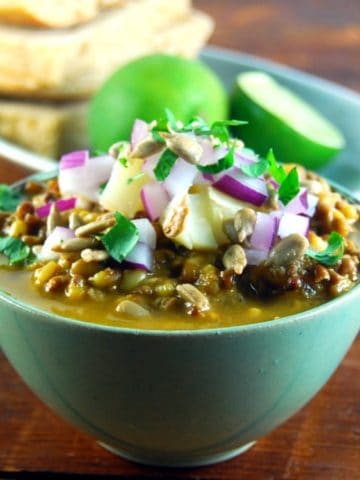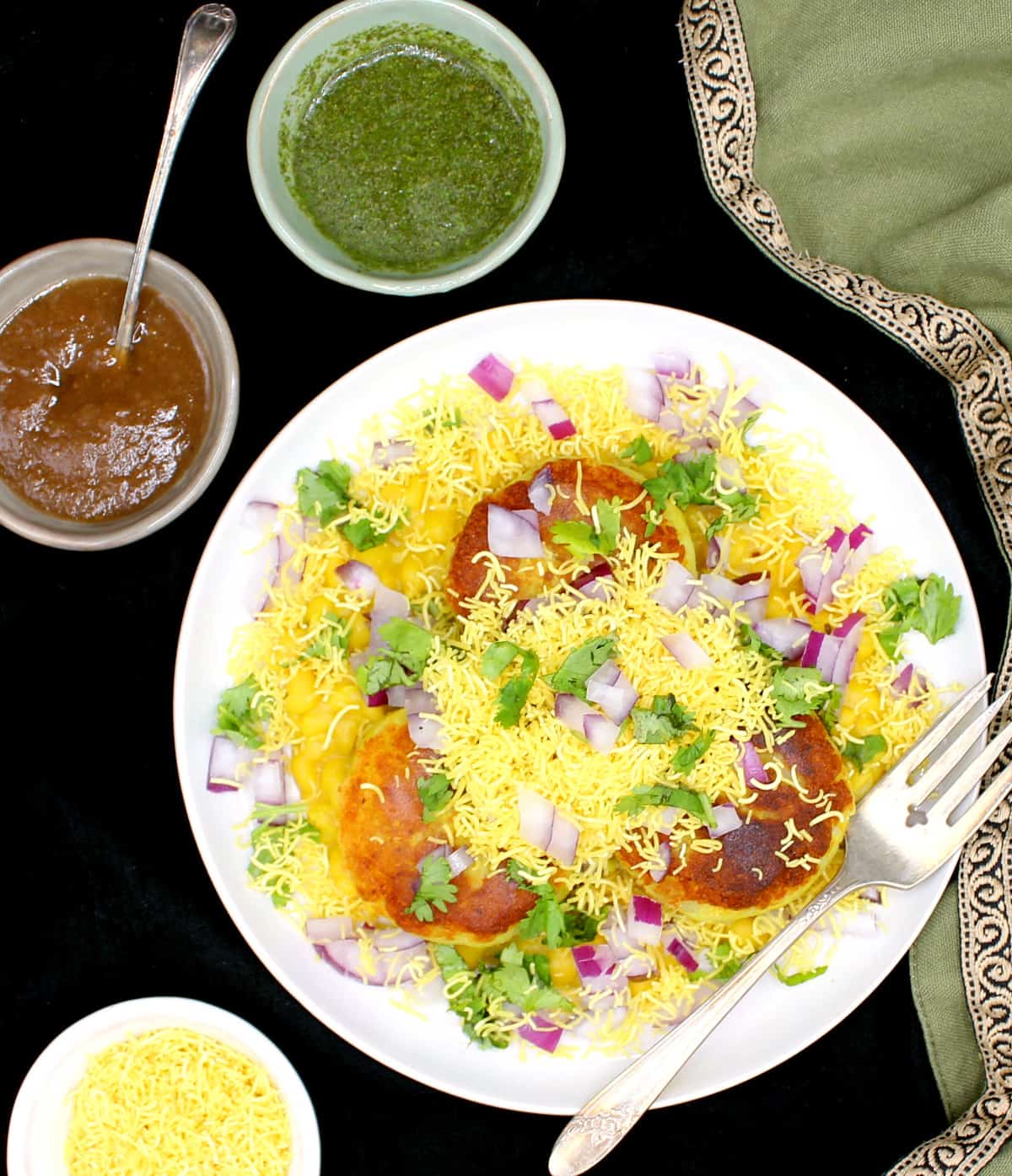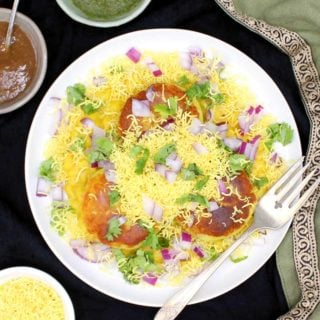You might also enjoy these recipes for aloo tikki and vegetable cutlet. Indian English speakers are tempted to change the spelling of this voluptuous snack – always spelled Ragda ‘Pattice’ by food vendors in Mumbai – to the more correct ragda “patties.’ But I say why spoil a good thing by forcing on it unneeded refinement? There’s nothing proper about this bold, tarty street snack from the swollen crush of Bombay’s streets. It is a hodge-podge of random flavors and textures that no cook in their right mind would dream of putting together. There’s sweet here and spicy and sour and salty. And then there’s creamy and crispy and crunchy and crumbly. The final result is lush genius on a plate. In Bombay, you can buy Ragda Pattice at the open stalls and carts lining the city’s long beaches and eat it standing right there, your feet burrowing into the soft sand and the sea breeze whipping your hair into a salty tango. Or, if you’re worried about hygiene and all that annoying stuff that gets between you and your indulgences, you can order it at one of the city’s restaurants. When I lived in Bombay, one of our go-to places after work was Vithal’s, a restaurant in the maze-like Fort area. Vithal’s offered almost every snack invented by the ingenious food hawkers of the city’s streets, and although you were sitting in an air-conditioned room that sealed you off from the humidly oppressive heat, the raucous laughter and voices of people young and old at the tables around you could easily make you think you were actually out there. I had one coworker who never ordered anything at Vithal’s but Ragda Pattice. She was that person who, although a vegetarian since birth, ate no vegetables other than potatoes (doesn’t everyone know someone like that?). And although I can’t think of a veggie I don’t love, I can easily see why she was so obsessed with the mighty Ragda Pattice.
Why you will love this recipe
This is one delicious snack! And it’s mostly potatoes and chickpeas, so it’s healthy as well. Kid-friendly and adult-friendly, because who doesn’t love potatoes? Has every flavor and texture you can imagine–tart, sweet, salty, spicy and soft, squishy, crispy and crusty–all in one plate, making it a gastronome’s dream come true. Extremely easy to make. The recipe needs just a handful of ingredients, and the sev can be store-bought–in fact, I don’t know anyone who actually makes it at home. Looks stunning. You will fall in love at first sight!
How to make ragda pattice
Make potato patties
The “pattice” in Ragda Pattice are two flat patties made with boiled and mashed potatoes, turmeric, salt and green chillies. They are fried to golden perfection with just enough oil to coat the pan. The patties are placed atop the white-pea sauce, or the ragda. White peas are not actually white but rather beige. You can find them in Indian stores and online and they work really well in this dish because they have a flavor that’s perfectly neutral and therefore perfectly wonderful here. Because here’s the secret to a perfect Ragda Pattice: you want the two building blocks – the ragda and the patties– to not have an overwhelming flavor. That way they can provide the perfect backdrop for all those delicious toppings that go on, like the sweet-spicy-sour tamarind sauce, the spicy green mint chutney, the crispy, savory sev (tiny yellow squiggles of chickpea flour you can buy in a packet at an Indian store), the pungent onion and the lemony, leafy coriander. To make the patties, boil and peel the potatoes–russets are great here–and then mash them to a very even consistency. Add in some rice flour, turmeric, minced green chili peppers and salt and form into small, smooth discs, about two-and-a-half inches across and a third of an inch thick. In a pan coated with oil, shallow-fry the patties until each side is golden-brown.
Make ragda
Soak the white peas overnight or at least for 3-4 hours, then pressure cook them with salt and water to cover by an inch or two, until very tender (five whistles should do the trick). If you’re using an Instant Pot, you can skip the soaking and just cook them, with some salt and covered with at least three inches of water, on the “beans” setting. If cooking on the stovetop, soaking overnight is strongly recommended. Place the peas in a pan, cover with two inches of water, bring to a boil, and let them simmer, covered, for about an hour or until very tender. Once you have the boiled peas, making the ragda couldn’t be easier. Heat a teaspoon or oil, add a teaspoon of ginger-garlic paste to it (don’t add more, you want softer flavors here, remember?), saute, and then add turmeric, minced green chili peppers like jalapeno or serrano, the peas and salt. Simmer for another 10 minutes, with some water, until you have a thick, chana-masala-like consistency.
Assemble and serve
Most Indian street food starts out with healthy building blocks, but what gives them the decadence of street eats is the junk you pile on top. In case of ragda pattice, most of the “junk” is healthy too. You want finely minced onions, minced coriander leaves, a tamarind-date chutney, and a spicy mint chutney. You can buy both chutneys off the shelf, although I’ll include recipes for them here. The only component here that’s probably not going to make your fitness app give you a hi-fi is the sev– tiny little deep-fried squiggles of chickpea flour that you can buy off the shelf at an Indian grocery store or online. Don’t skip it, it just makes everything more delicious and adds so much crunch and texture. To serve the ragda pattice, you’ll put some ragda on the plate, place the patties on top, drizzle on the two chutneys, scatter onions and cilantro, and finally sprinkle sev over it all. Magic on a plate.
More delicious Indian street food recipes
Recipe card
Check to get new recipe updates by email.
